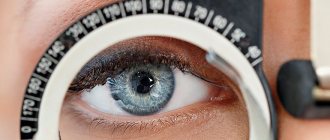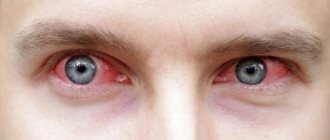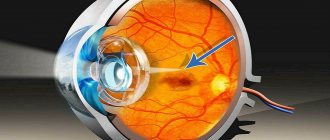Hemeralopia is a decrease in visual acuity during twilight hours.
The lower the illumination of the room, the worse the patient sees. There are several reasons for the development of the disease.
It can manifest itself from a hereditary factor or when the intake of vitamin A into the body decreases. In both cases, a complete diagnosis of the condition of the patient’s visual organs and treatment are required. Timely initiation of therapy reduces the risk of deterioration of the visual organs up to complete blindness.
Where does the name “night blindness” come from?
All people have a retina in the internal structure of the eye. It is penetrated by blood vessels and nerve fibers. The nerve endings are called rods and cones. The name comes from their shape. The rods are elongated, and the cones have a bulge in the middle, like a flask. These formations perceive black and white or color images.
The pigment rhodopsin is located on the rods. If the patient is in daylight, rhodopsin is present in the rods. With the onset of darkness, the substance disintegrates and returns to its structure only when daylight comes. In patients suffering from night blindness, this process is slowed down or completely absent. Vitamin A is required for normal synthesis of rhodopsin. If its amount decreases, the substance cannot recover after destruction.
The disease is called night blindness due to the fact that only rods are located on the retina of chickens. Therefore, their vision is black and white. When twilight sets in, they completely lose their vision function and see nothing. This is why chickens fall asleep as soon as there is less light.
Why is hemeralopia dangerous?
Regardless of what causes the disease, its development can be fraught with negative consequences. Night blindness may indicate the development of other diseases, such as glaucoma or myopia. Drivers suffering from it stop recognizing road signs, which creates a dangerous situation. Hemeralopia also causes internal discomfort, fear of complete blindness appears, and children with this disorder develop a persistent fear of the dark. If not treated on time, it can develop into a mental disorder.
Causes of hemeralopia
Most often, the disease is inherited. But not all patients experience it. This requires damaging factors:
- reduced intake of nutrients into the body, including vitamin A;
- excessive consumption of alcohol, which reduces the absorption of nutrients and slows down metabolism;
- exhaustion of the body, as a result of which the amount of vitamins, microelements, and minerals necessary for life is reduced;
- inflammatory diseases of the gastrointestinal tract, due to which the absorption of nutrients is reduced;
- anemia;
- diabetes;
- intoxication of the body.
There is a type of night blindness that occurs as a result of complications from diseases of the organs of vision:
- increased intraocular pressure, which leads to glaucoma;
- clouding of the lens, forming a cataract;
- inflammatory condition of the retina.
In the hereditary form of the pathology, blindness occurs immediately after birth or after some time. Initially, the child cannot explain his condition, so he becomes nervous when the concentration of light decreases. At this stage, it is necessary to consult with an ophthalmologist in order to begin treatment on time.
Types and classifications
There are four main types of hemeralopia. Each of them has its own characteristics, specifics and classifications.
Congenital
This type of disease is inherited and its symptoms can be noticed at a fairly early age. The following factors can provoke this:
- Genetic diseases;
- Retinitis pigmentosa.
Essential (with a lack of vitamins)
It provokes disruptions in the functioning of the retina. This can be caused by a deficiency of vitamins A, PP, B2, and less commonly, zinc. This malaise can be caused by a disruption in the flow of these beneficial compounds into the body. Poor diet, lack of food, liver failure or stomach disease can all lead to hemeralopia.
One of the functions of the retina is the timely enrichment of the vitreous body and adjacent tissues with essential vitamins and minerals. With chronic local vitamin deficiency, the ability of the corneal elements to perceive not only colors and shades is lost, but also loss of orientation at night.
Symptomatic
This type of hemeralopia is possible in the presence of eye diseases that affect the retina or optic nerve. It can be provoked by: myopia, glaucoma, tapetoretinal dystrophy, chorioretinitis, optic nerve atrophy, siderosis.
False
It is caused by ordinary eye fatigue - this is also constant watching TV, working at the computer. In this case, it is not really a disease, but a signal that the eyes need rest and rest.
The course of treatment depends on the type of disease.
Diagnostics
Diagnosis of the patient’s visual organs is carried out in several stages:
- Anamnesis collection. This is data obtained from the words of the patient or his close relatives. Based on them, the doctor may order further testing.
- Tests to measure visual acuity. For this purpose, diagnostic tables are used, on which symbols, letters, and pictures are drawn. The doctor looks at how many rows from the table the patient sees.
- General examination of the condition of human skin surfaces and mucous membranes. If the condition is caused by a lack of vitamins, bleeding gums, redness of the conjunctiva of the eyes, and hair loss may occur.
- Fundus examination. To do this, a solution is first instilled onto the mucous membrane, which disrupts the accommodation of the pupil. The doctor evaluates the condition of the lens, vitreous body, chambers, retina and microcirculation vessels.
The diagnosis of night blindness can be made based on the patient's complaints. But its causes can be identified using diagnostic tests.
Possible complications
Night blindness itself does not pose any serious threats to human life. However, it is worth considering that basically this disease is a consequence of other, much more dangerous and unpleasant diseases. Also, a lack of vitamins leads to depletion of the structural components of the eye (vitreous body, cornea, retina, optic nerve), which leads to complications in the form of glaucoma, cataracts and other diseases that are difficult to treat.
Complications are that other serious diseases may appear. Also, not all types of hemeralopia can be cured. It all depends on the type and severity of the problem.
Treatment
If the patient's condition is caused by a hereditary factor, it is impossible to prevent the development of the disease. He must learn to live with reduced visual acuity at dusk.
When a disease develops due to damage to the internal structures of the eyes, the underlying disease is treated. Conservative therapy is prescribed using drops to eliminate glaucoma and cataracts. If this is not enough, a surgical method is used.
If the disease is caused by a decrease in the intake of vitamins, it is recommended to adhere to the following diet:
- eating plant foods in the form of fruits, vegetables, herbs, berries;
- introduction of dairy products into the diet: cheese, sour cream, cottage cheese, milk;
- Chicken eggs are introduced into the diet several times a week, the yolk is especially useful;
- They eat different types of liver: chicken, beef, pork;
- introduce fish and seafood into the diet.
During illness, some patients complain of the formation of dry mucous membranes of the eyes. In this case, the doctor may prescribe medications that help preserve the tear film on the surface structures of the eyes.
Factors provoking hemeralopia
The disease is divided into several groups.
Essential blindness , which appears as a result of a lack of zinc and certain vitamins.
The problem is also caused by:
- unbalanced diet;
- addiction to alcohol and sweets;
- severe exhaustion;
- serious intoxication;
- inflammatory diseases of the stomach, biliary tract or kidneys;
- anemia;
- diabetes.
Symptomatic blindness is a consequence of the development of eye diseases, such as hypermetropia, glaucoma, cataracts, and others. Sometimes the problem is caused by treatment with retinol (vitamin A) antagonist drugs, one of which may be quinine.
Congenital blindness is a consequence of an abnormality in the formation and development of the retina, which occurs in Usher syndrome. Such night blindness develops from an early age and is hereditary.
Night blindness is sometimes caused by addiction to strict diets, severely limited in the choice of foods, and vegetarianism. Women's vision may decrease during menopause. Measles, herpes and even chickenpox also sometimes cause hemeralopia.
A disease that reduces visual acuity is sometimes defined by doctors as “false night blindness,” which develops when the visual organs are overworked. There is no need to treat such hemeralopia with medications: proper rest is enough for it to disappear on its own.
Prevention
The hereditary form of the disease cannot be prevented. If the disease is caused by a nutritional factor, that is, a reduced supply of nutrients to the blood, it is recommended to adhere to the following rules:
- a balanced diet, with the help of which the body receives all useful substances and vitamins;
- consumption of vitamin complexes in the autumn-winter period, when their amount in products is reduced;
- timely treatment of all inflammatory diseases of the gastrointestinal tract to prevent malabsorption of nutrients.
Night blindness is a disease due to which a person loses perception of the surrounding space during twilight. To prevent the development of complications, you should fully adhere to the doctor’s recommendations for treating the disease.
Symptoms
One of the noticeable signs of night blindness is the long adaptation of the eyes when moving from a light room to a dark one. It takes a long time for a person to get used to light or dark lighting and see poorly at first. The following signs may also indicate the presence of this disease:
- narrowing of the field of view, deterioration of peripheral vision;
- difficulties with orientation in space in low light;
- deterioration of color perception, especially blue and yellow colors;
- dark spots before the eyes;
- dry cornea.
If such symptoms occur, it is necessary to visit an ophthalmologist, who will determine their cause.
Causes
The causes of hemeralopia are varied.
These include:
- lack of vitamins;
- many eye diseases, both congenital and acquired during life;
- hereditary factors;
- overexertion and stress;
- weakening of the body due to exposure to infectious agents;
- prolonged hunger;
- psychosomatic defect;
- anemia;
- liver and kidney pathologies;
- intoxication with various substances;
- long-term use of medications that affect the absorption of vitamin A, etc.
Many doctors believe that psychosomatics can play a role in the formation of night blindness. A similar defect is typical for people prone to hysterics and exaggerations of various kinds. It is also popularly called hysterical blindness.
Causes of blindness in chickens, treatment
Chickens go blind for various reasons. Sometimes eye problems are caused by an injury received while walking or during a fight with relatives. In this case, the general condition of the bird does not deteriorate. However, if vision loss is caused by a progressive viral or bacterial infection, other symptoms of the disease may also be present.
The hen has an eye problem
Poor nutrition is another cause of blindness in chickens. Due to a lack of vitamins, the bird’s body weakens, its general condition worsens, and pathologies of the digestive, endocrine and immune systems develop. All this leads to complete or partial loss of vision. The conditions in which birds are kept also affect their eyes. If ventilation is not provided in the chicken coop, the chickens suffer from ammonia vapors accumulating in the room, which causes them to go blind.
Diseases and conditions leading to vision loss in chickens:
- salmonellosis;
- avitaminosis;
- hemophilosis;
- sinusitis;
- neurolymphomatosis;
- chlamydia;
- mycoplasmosis;
- conjunctivitis;
- panophthalmitis;
- eye injuries and tumors;
- ammonia blindness.
The most common cause of night blindness is salmonellosis.
This disease is caused by Salmonella enterobacteria. They enter the body of birds along with food. A laying hen can infect her offspring through eggshells. The disease's symptoms are similar to gastroenteritis. In chickens it is acute and progresses quickly, causing profuse diarrhea and intoxication. In adult chickens, salmonellosis occurs in a chronic form, the clinical picture is blurred.
Salmonellosis leads to blindness
Symptoms of infection:
- weakness;
- strong thirst;
- stool disorder;
- loss of appetite;
- ruffled feathers;
- decreased egg production;
- lameness;
- eyelids are enlarged.
Attention! Salmonella first affects the digestive organs, and then penetrates the lymphatic system and spreads throughout the body. By releasing enterotoxins, microorganisms disrupt the functioning of internal organs, cause inflammation of the joints and even blindness.
Treatment of blindness in chickens due to salmonellosis is effective at the early stage of the disease. Birds are given antibiotics to which the bacteria are sensitive:
- Enrofloxacin;
- Levomycetin;
- Oxytetracycline;
- Gentamicin.
The course of treatment lasts 5 days. Then the bird is fed with probiotics to restore the intestinal microflora. Unfortunately, if vision is partially lost as a result of an infectious disease, it cannot be restored.
Vitamin A deficiency
A complete and varied diet is the key to healthy laying hens. If it lacks vitamin A, birds may lose their vision. A lack of retinol negatively affects the functioning of the body's endocrine and digestive systems. This vitamin regulates the functioning of light-sensitive pigments of the retina and therefore plays a vital role in the functioning of the visual organs.
Vitamin A is found in carrots and pumpkin
Due to a lack of retinol, sicca keratitis may develop, which is associated with drying out of the mucous membrane of the eyeballs. This will lead to a decrease in its protective functions and will help create a favorable environment for the development of eye infections. Lack of treatment is fraught with serious consequences, including necrosis of eye tissue and complete loss of vision.
Symptoms of vitamin A deficiency in chicken:
- dry cornea;
- frequent inflammatory eye diseases;
- shaking the head from side to side;
- weight loss;
- general weakness;
- loss of interest in food;
- lack of coordination.
Treatment of night blindness caused by vitamin deficiency involves replenishing vitamin A deficiency in the bird’s body. For a quick recovery, veterinarians recommend adding retinol to the food. Orange vegetables are included in the diet - grated carrots and pumpkin, as well as corn, millet and fresh herbs.
Hemophilosis
This disease is also called infectious rhinitis, which, according to scientists, is caused by a gram-negative bacterium, Haemophilus influenzae. Transmission routes are alimentary and aerogenic. The disease spreads very quickly and covers most of the livestock within 2–4 days. Having penetrated the body, pathogens multiply in the upper respiratory tract and on the mucous membranes of the nose and eyes.
Foamy discharge from the eyes due to an infectious runny nose
Symptoms:
- conjunctivitis - pus and cheesy mass are released from the eyes;
- swelling of the facial part of the head;
- severe runny nose;
- paleness of the comb and earrings;
- reduction in egg production by 20–30%;
- the bird shakes its head, rubs it on the ground or its wings;
- apathy;
- heavy breathing, sneezing.
Attention! If left untreated, hemophilosis leads to blindness as bacteria destroy the retina of the eyes.
The prognosis for recovery is favorable - if the disease proceeds without complications, the bird will recover within 2 weeks. Moreover, among individuals with weakened immune systems and chickens, mortality reaches 10%.
The bacteria that cause infectious rhinitis are sensitive to sulfonamide drugs and antibiotics. Medicines used for treatment:
- Timil-250;
- Bi-septim;
- Septovet.
Marek's disease (neurolymphomatosis)
This is an infectious disease caused by a virus from the Gammaherpesviridae family. In its acute form, it is characterized by the formation of tumors on the body and internal organs. The chronic course is accompanied by disturbances in the functioning of the nervous system, paralysis, and blindness.
Marek's disease
The duration of the incubation period for the chronic form is 14–20 days. Chickens show signs of damage to the peripheral and central nervous system, such as lameness, paralysis of the wings and paws. One of the symptoms of Marek's disease is a deformation of the pupil and a change in its color, after which partial or complete blindness occurs. The prognosis is unfavorable - infected birds die from exhaustion in 80% of cases.
Attention! Marek's disease has no cure. Once the diagnosis is confirmed, all birds that have been in contact with sick individuals are destroyed. Conditionally healthy birds are vaccinated with a special vaccine.
Psittacosis
Chickens rarely get psittacosis, but such cases do occur. The causative agent is the intracellular microorganisms chlamydia. In adult laying hens the disease is usually chronic. Symptoms:
- decreased egg production;
- poor appetite;
- unkempt feathers;
- photophobia;
- swelling around the eyes;
- convulsions;
- liquid droppings.
Chlamydia in birds is dangerous for humans, so chickens are not treated, but destroyed. There are no vaccines to protect against psittacosis.
Mycoplasmosis
Mycoplasmas are the simplest microorganisms that occupy an intermediate position between bacteria and viruses. For this reason, the disease has symptoms similar to viral and bacterial infections:
- cough;
- sneezing;
- swelling and inflammation of the eyes;
- tearfulness;
- discharge of mucous exudate from the nasal passages;
- weight loss;
- decreased egg production;
- lameness.
Medicine for mycoplasmosis – Tylosin
Attention! Adult chickens are less susceptible to infection with mycoplasmosis than young chickens, but even after completing the course of treatment, the health of the birds is not completely restored. Lost vision cannot be restored either.
Antibiotics to which mycoplasmas are sensitive:
- Tylosin;
- Doxycycline;
- Ofloxacin;
- Oxytetracycline.
Conjunctivitis
Inflammation of the mucous membrane of the eye is called conjunctivitis. This disease can be caused either by a viral or bacterial infection, or by mechanical trauma or irritation of the cornea. Symptoms:
- redness of the area around the eyes;
- tearfulness;
- eyelid gluing;
- discharge of pus from the eyes.
To treat conjunctivitis, eye drops are used - Floxal, Albucid and tetracycline ointment. Before using medications, discharge is removed using a clean cotton pad soaked in warm boiled water. If left untreated, the chicken may lose its vision.
Tetracycline ointment treats conjunctivitis
Panophthalmitis
This disease develops as a complication after untreated conjunctivitis. Panophthalmitis is characterized by a purulent inflammatory process affecting the eyeball. Symptoms:
- the eye does not move;
- pus is discharged profusely;
- the cornea becomes cloudy;
- Sometimes blood comes out of the eye.
Treatment is carried out with broad-spectrum antibiotics. Several times a day, a sick bird's eyes are washed with disinfectant solutions to remove pus and relieve inflammation. In especially severe cases, they resort to surgery and removal of the eyeball.
Injuries and tumors
Domestic chickens often injure their eyes during a walk or an unsuccessful attempt to descend from a roost. Clashes often occur between roosters, resulting in wounds and abrasions, including in the eye area. The injured bird needs to be helped as soon as possible.
First, the damaged eye is washed with a weak solution of boric acid or chlorhexidine. If a foreign object gets inside, it is removed. In most cases, serious treatment will not be needed. However, if the eye turns red and signs of purulent conjunctivitis develop, you should show the chicken to a veterinarian. He will do an examination and advise which drops are best to use.
Lump on a chicken's eye
Eye tumors are rare in chickens. They look like bumps. One of the reasons for their appearance is hereditary factors and genetic mutations. However, some farmers call swelling of the eyelids a tumor. This picture is observed when grains of sand, soil, sawdust or food particles enter the organs of vision. Helping the bird involves removing the foreign object and rinsing the eyelids with a warm chamomile decoction.
Ammonia blindness in chickens
High concentrations of ammonia vapor in a chicken coop cause ammonia blindness in chickens. This is a non-contagious disease, but if the conditions of detention are violated, it develops in several individuals at once. Young animals are at risk, since chickens have very sensitive mucous membranes.
Symptoms of ammonia vapor poisoning:
- coughing;
- lethargy;
- redness of the eyelids;
- corneal clouding;
- foamy discharge from the eyes.
The chicken's eyelids turned red
Having discovered such clinical signs, you should invite a veterinarian to rule out infectious diseases. Chickens can be cured using corticosteroids. When a bacterial infection occurs, antibiotics are used.
Attention! It is important to improve the conditions for keeping poultry - the chicken coop should be ventilated so that harmful fumes released from bird droppings do not accumulate inside. The problem can be solved by installing supply and exhaust ventilation.
Diagnostic measures
A doctor can suspect hemeralopia after listening to the patient’s complaints. After this, an instrumental examination is carried out, which confirms or refutes the diagnosis. It is recommended to perform electroretinography to accurately identify pathological changes in the retina.
The patient is recommended to undergo a general blood test. If hemoglobin is reduced, then the cause of visual impairment may be poor nutrition or metabolic disorders.
In some cases, it is necessary to involve other specialists to identify the root cause of the disease. This could be a neurologist, traumatologist, hematologist or gastroenterologist.









